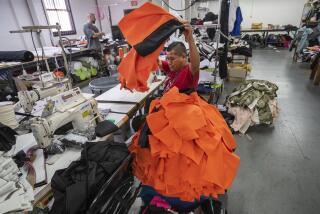Three Quarters of Monthly Gain Attributed to Surge in Aircraft Orders : Factory Orders Up 2.5% in December, 7.4% for Year
- Share via
WASHINGTON — Factory orders, propelled by heavy demand for aircraft, surged 2.5% in December, closing out the best year for American manufacturers since 1984, the government said Wednesday.
The Commerce Department said that orders for both durable and non-durable manufactured goods amounted to a seasonally adjusted $214.77 billion in December, an increase of $5.14 billion over the November level.
The 2.5% advance was the strongest since a similar 2.5% rise last March, but almost three-fourths of the December strength came from a huge 41.1% jump in aircraft orders.
Orders Total $2.44 Trillion
Even though the orders report was heavily influenced by a single category, analysts said there were sizable gains in other sectors as well, reflecting continued strength in U.S. manufacturing.
“This report shows an extremely healthy manufacturing sector with essentially no signs to suggest that manufacturing will not play a key role in sustaining the expansion in 1988,” said Allen Sinai, chief economist of the Boston Co.
For all of 1987, orders to American manufacturers rose 7.3% to $2.44 trillion. It was the best performance since a 9.3% advance in 1984.
In 1986, manufacturing orders actually fell 0.6% following a tiny 0.3% advance in 1985. In both of those years, American manufacturers were in a virtual recession with plant closings and employment layoffs forced by intense foreign competition.
However, 1987 saw a turnaround as the Reagan Administration’s effort to drive the value of the dollar lower to boost U.S. exports began to show results.
Pin Hopes On Manufacturing
Economists who believe that the country will escape a recession in 1988 are pinning much of their hope on continued strength in manufacturing.
Sinai said he expected that manufacturing orders would continue to rise this year with much of the demand coming from U.S. companies adding computers and heavy machinery to expand their own production facilities.
“It confirms a pattern we’ve been expecting,” said Laurence Meyer, president of Laurence Meyer & Associates in St. Louis, Mo. “There’s no question we’re going to see a slowing in production in the first half (of 1988), but with underlying strength in capital goods orders that suggests we’re not in for a persistent downturn.”
Meyer said he expected gross national product would fall about 0.4% in the first three months of 1988 before expanding 1% in the second quarter.
“We’re going to skirt the edges of a recession,” he said, but avoid a major slump. A recession is generally defined as two successive quarters of decline in economic production.
In December, orders in the volatile defense category fell 3% to $9.44 billion after a 2.6% drop in November.
Capital Goods Orders Up 11.5%
Orders for non-defense capital goods, considered a good indication of industry plans to expand and modernize production facilities, shot up 11.5% in December to $33.56 billion after a 1.1% November decline.
For the year, capital goods orders rose 11.1%, rebounding from a lackluster 1.1% increase in 1986. It is this category that is expected to show further strength in 1988.
More to Read
Inside the business of entertainment
The Wide Shot brings you news, analysis and insights on everything from streaming wars to production — and what it all means for the future.
You may occasionally receive promotional content from the Los Angeles Times.









